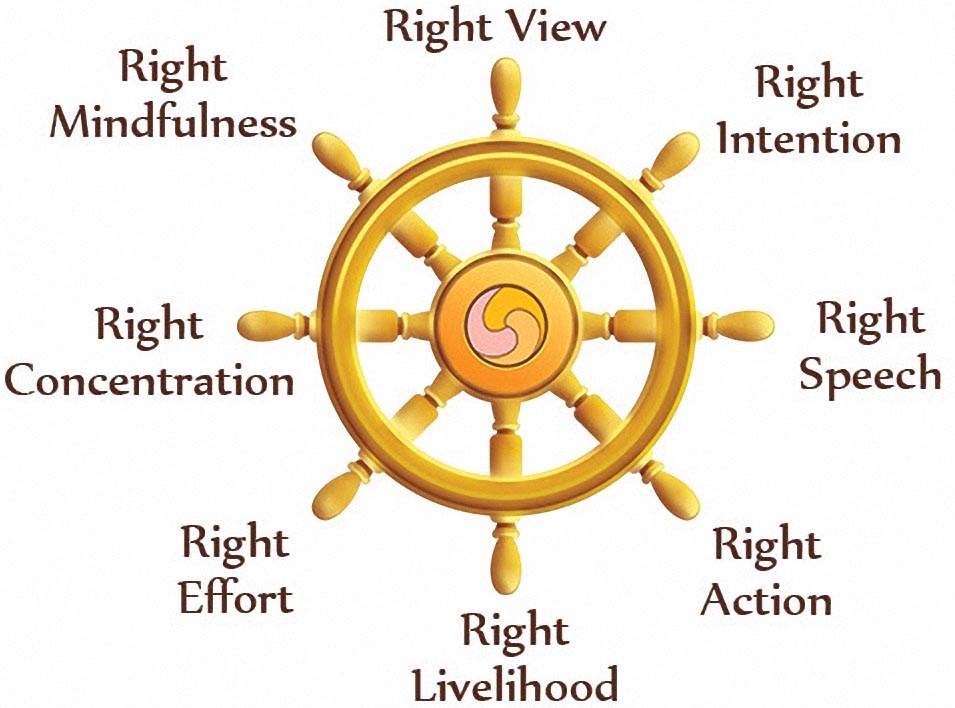'The Four Noble Truths' the truth of suffering, the truth of the origin of suffering, the truth of the cessation of suffering and the truth of the path leading to this cessation was the first sermon the Buddha gave after he was enlightened. I want in this paper, offered in honour of Professor J. de Jong, to examine the grammar and syntax of something which, although The Eightfold Path is the fourth Truth of the Four Noble Truths. Very basically, the truths explain the nature of our dissatisfaction with life. His Holiness the Dalai Lama outlined each of the four noble truths in this teaching in Dharamsala in 1981. That is why the Four Noble Truths and the two truths are the essence of the first teachings of the Buddha. The First Noble Truth The first noble truth is the full understanding of suffering. Four Noble Truths: The Four Noble Truths constitute a fundamental doctrine of Buddhism and were set forth by the Buddha in his first sermon after his enlightenment. The Four Noble Truths and the Noble Eightfold Path are fundamental teachings in Buddhism. They are considered equally important among all the Buddhist school The Four Noble Truths (Skt. 'phags pa'i bden pa bzhi) or the Four Realities of the Aryas, were taught by Buddha Shakyamuni as the central theme of the socalled first turning of the wheel of the Dharma. The Four Noble Truths are presented within new contexts, and sometimes given a different emphasis and importance. An example of these changes is the Lotus Sutra. The text of the Lotus Sutra refers to The Four Noble Truths as the first teaching of The Buddha. This was originally designed for a low abilty SEN group but may be suitable for KS2 looking at the four noble truths and reflecting on our own feelings (SEAL) The four noble truths are well known as the Buddha's first and most essential explanation of his enlightened realizations. The truths diagnose the human existential crisissuffering and its originand prescribe a solutioncessation and the path. The Four Aryan (or Noble) Truths are perhaps the most basic formulation of the Buddhas teaching. They are expressed as follows: 1. The Four Noble Truths are a Buddhist teaching. The First Noble Truth: Dukkha Life is full of suffering. Dukkha usually is translated as suffering. The Four Noble Truths represent the foundation of Buddhism. Ready to learn more about Buddhism? The Four Noble Truths structure the entire teaching of the Buddha, containing its many other principles just as the elephants footprint contains the footprints of all other animals. The pivotal notion around which the truths revolve is that of dukkha, translated here as suffering. The first of the Buddha's sermons after his enlightenment was describing The Four Noble Truths; that life brings suffering, that suffering is part of living, that suffering can be ended and that there is a path that leads to the end of suffering. Among the various meanings of the word noble, my dictionary lists preeminent, highly virtuous, and deserving respect. The noble truths are noble in all three of these senses, writes Thanissaro Bhikkhu. This lesson will explain the Four Noble Truths of Buddhism. In doing so, it will explain the origins of Buddhism and the life of Siddhartha I teach about suffering and the way to end it Shakyamuni Buddha. The teachings on the four noble truths are among the very first of many teachings that Shakyamuni Buddha gave in Sarnath (near Benares or Varanasi in NorthEast India), seven weeks after attaining enlightenment in. by Ron Kurtus (revised 10 June 2017) The basis of Buddhism is a doctrine known as the Four Noble Truths. The First Truth is that all life is suffering, pain, and misery. The Truth of Suffering (Kutai) The Buddha declared that this world if full of suffering; that actual existence including birth, decrepitude, sickness and death is suffering and sorrow. Sariputta: Friends, just as the footprints of all legged animals are encompassed by the footprint of the elephant, and the elephant's footprint is reckoned the foremost among them in terms of size; in the same way, all skillful qualities are gathered under the four noble truths. Under the noble truth of stress, under the noble truth of the origination of stress, under. FIRST NOBLE TRUTH What is the Noble Truth of Suffering? Birth is suffering, aging is suffering, and death is suffering. Disassociation from the loved is suffering, not to get what one wants is suffering Through not seeing the Four Noble truths Long was the weary path from birth to birth. When these are known, removed is rebirths cause, The root of sorrow plucked; then ends rebirth. This is the noble truth of suffering: birth is suffering, aging is suffering, illness is suffering, death is The EightFold Path is the fourth of the Four Noble Truths the first of the Buddha's teachings. All the teachings flow from this foundation. What Are the Four Noble Truths? The Four Noble Truths are the Buddhas explanation (if he was a Doctor) of the disease, the cause of the disease, the prognosis, and. The Four Noble Truths The first noble truth. The first noble truth is called Dukkha, which means suffering. It says that life is full of suffering. To say it a different way, in life, there is sickness, poverty (being poor), old age, and death. People can not keep what they want. How to Understand the Four Noble Truths. The Four Noble Truths are the core of Buddhist beliefs. These were the first teachings given by the Buddha after he attained enlightenment. They are four simple teachings that describe the way life An introduction to the Four Noble Truths, Buddhas unique approach to the problem of suffering, and how it can be solved. This article examines the Four Noble Truths, four principles which contain the essence of the Buddha's teachings. The Four Noble Truths, Core concepts in Buddhism. Often misunderstood, the 4 noble truths can be simplified and applied to our lives to release suffering. The Four Noble Truths are sometimes compared to a doctor diagnosing and treating an illness. The First Truth is the diagnosis of a problem, the Second Truth is the cause of the illness, and the Third is the truth that there is a cure (and the Fourth is the prescription). Buddhism: The Four Noble Truths. Buddha said You should know sufferings, you should abandon origins, you should attain cessations, you should practice the path. The four truths are suffering, the birth of suffering, the end of suffering, and the path to the end of suffering. Buddha was motivated to relieve the suffering of beings, which is the basis for these truths. The Four Noble Truths They are the truth of suffering, the truth of the cause of suffering, the truth of the end of suffering, and the truth of the path that leads to the end of suffering. Information and explanation of The Four Noble Truths of Buddha and Buddhism. The Four Noble Truth is the basis of Buddhism, and from here, we understand our cyclic existence in this samsaric realm. Only by applying Buddhas way of. The Noble Truth of the Cessation of Suffering. the Buddhas teaching on the Four Noble Truths. For me this is a very tempting idea. The workings of the mind are examined with great precision in these teachings of the Buddha that originated in India over 2000 years back. However the way to freedom lies not in a scholarly study of these teachings, but instead in practicing meditation and mindfulness. These four truths are called noble because they liberate us from suffering. They are the Buddhas basic teaching, encapsulating the entire Buddhist path. Four noble truths definition, the doctrines of Buddha: all life is suffering, the cause of suffering is ignorant desire, this desire can be destroyed, the means to this is the Eightfold Path. The Buddha's first sermon after his Enlightenment centered on the Four Noble Truths. Begin learning what these 4 foundations of Buddhism mean. The message of Buddhas Four Noble Truths is that paying attention and seeing clearly lead to behaving impeccably in every moment, out of love, and on behalf of all beings. Accounts of the Buddhas life, said to have been told by generations of disciples before they were written down and. What is the Noble Truth of Suffering? Birth is suffering, aging is suffering, sickness is the belief that there is an afterlife and not everything ends with death, that Buddha taught and followed a successful path to nirvana; according to Peter Harvey, the right view is held in Buddhism as a belief in the Buddhist principles of karma and rebirth, and the importance of. The four noble truths are the most basic expression of the Buddha's teaching. Sariputta once said, they encompass the entire teaching, just as the footprint of an elephant can encompass the footprints of all other footed beings on earth. The Buddhist teaching known in English as the four noble truths is most often understood as the single most important teaching of the historical buddha, Siddhartha Gautama, who taught in northern India during the 5th century bce. Sanskrit dukha and Pali dukkha (pain), samudayo (arising.











